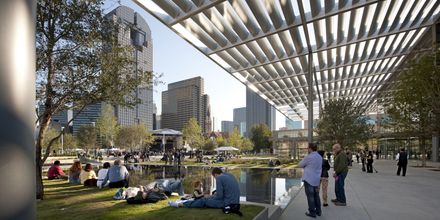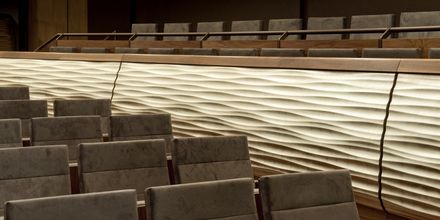
Winspear Opera House
ARCHITECTS
Foster + Partners
CLIENT
AT+T Performing Arts Center
ADA CONSULTANT
McGuire Associates
MANUFACTURERS
POHL, Skyfold, Acme Brick, Basaltina, Casavant, Enterprise Precast Concrete, Fellert, Figaro system, Formglas, Gala Systems, St. Cloud Window, Theater Solutions, Whitley Construction Company, Zahner
SERVICES ENGINEERS
Battle McCarthy, CHP & Associates
STRUCTURAL ENGINEERS
Buro Happold, Thornton Tomasetti
LIGHTING CONSULTANT
Claude Engle Lighting Consultant
TRANSPORTATION CONSULTING
Deshazo, Tang
SOUND SYSTEM DESIGN
Engineering Harmonics
COST CONSULTANTS
Donnell Consultants
GEOTECHNICAL ENGINEERS
GME Consulting Services Inc., Landscape Designers Michel Desvigne, JJR, Kevin Sloan
MAIN CONTRACTOR
Linbeck
ELEVATOR CONSULTANT
Persohn Hahn Associates
ACOUSTICIAN
Sound Space Design
THEATRE CONSULTANT
Theatre Projects
PARKING CONSULTANTS
Carl Walker Inc.
CURTAIN WALL CONSULTANT
LZA Technology
TEAM
Norman Foster, Spencer de Grey, Stefan Behling, Michael Jones, James McGrath, Bjørn Polzin, Laszlo Pallagi, Morgan Fleming, Leonhard Weil, John Small, Ingrid Sölken, Hugh Whitehead, Francis Aish
FOODSERVICE CONSULTANTS
JGL Management Services
SECURITY
HMA Consulting
GRAPHIC CONSULTANT
2 x 4
ACOUSTICAL AND VIBRATION CONSULTANT
Wilson, Ihrig & Associates, Inc.
ARCHITECT FOR THE PARKING GARAGE
Good Fulton & Farrell
COLLABORATING ARCHITECT
Kendall/Heaton Associates
CODE CONSULTANTS
Pielow Fair
YEAR
2009
LOCATION
500, 2403 Flora St, Dallas, TX 75201, United States
CATEGORY
Opera House
Text description provided by architect.
The new Winspear Opera House in Dallas redefines the essence of an opera house for the twenty first century, breaking down barriers to make opera more accessible for a wider audience.
Responding to the Dallas climate, a generous solar canopy extends from the building, revealing below a fully glazed sixty foot high lobby.
This establishes a direct relationship between inside and outside, enhancing transparency.
Beneath the canopy, which forms an integral part of the environmental strategy -a shaded pedestrian plaza creates a major new public space for Dallas, defined by the masterplan for the Performing Arts District.
The masterplan was designed by Foster + Partners and OMA with Michel Desvigne.
The opera house, with its canopy on the orthogonal grid generated by Flora Street, is the focal point of the District, which also includes the Dee and Charles Wyly Theater, the Booker T Washington High School, the Morton H.
Meyerson Symphony Center and in the future, the new City Performance Hall.
Around the Opera House itself, angled off-grid under the canopy, there is the Annette Strauss Artists’ Square,with its outdoor performance space for an audience of 5000, a smaller outdoor performance space with a café terrace and the main entrance with access to the parking garage.
Together with Sammons Park, the public plaza, these spaces form an integral part of the project, connecting with the city at an urban scale.
Organisationally, the Winspear creates a transparent, publicly welcoming series of spaces, which wrap around the rich red glass drum of the 2,200-seat auditorium.
The building is not only fully integrated with the cultural life of Dallas, but will be a destination in its own right for the non-opera going public,with a restaurant and café that is publicly accessible throughout the day.
Entered beneath a lower canopy, the transition from the Grand Plaza through the foyer into the auditorium is designed to heighten the drama of attending a performance – in effect, ‘to take the theatre to the audience’.
The grand staircase, flowing from one side to the other around the drum, links all the lobby spaces and also provides an opportunity for the audience to stop, discuss and observe.Deep gouges in the drum itself allow the audience to move horizontally at each of the balcony levels.
The auditorium itself creates a sense of intimacy with the performers. Working with Theatre Projects, a horseshoe plan combined with the dramatic vertical stacking of its seating balconies ensure that the audience is as close as possible to the stage.
Intimacy is further reinforced by emphasising the balcony fronts, with their white gold finish highlighted against the rich dark red interior.
The acoustics, designed by Bob Essert of Sound Space Design, are also enhanced by the compactness of the auditorium.
The detail and finishes improve the resonance of the human voice, making the orchestra sound rich but clear.The detail and finishes improve the resonance of the human voice, making the orchestra sound rich but clear.
To heighten the sense of drama, there is a chandelier creating an inverted cone of light and produced from an assembly of 320 acrylic rods that ascends into the ceiling of the auditorium at the beginning of the performance.
To complete the auditorium, the distinguished Argentinean artist Guillermo Quintero has designed a mesmerising curtain for the stage.
Punctuated with indigenous trees, the sheltered public areas beneath the canopy benefit from a cool, shaded microclimate.
Vertical sliding glass panels moving the full length of the east façade allow the building with its cafe and restaurant to be fully opened up, further enhancing the transitional inside-outside nature of the space.
The Grand Plaza responds to the grid of the opera house canopy with a scored pattern set into the concrete, referencing the wider urban grid of Dallas.
The Plaza contains squares of lawn and wildflower planting, with the Donor Pool as the focus.
This black granite water feature is set into the paving, with a film of water glistening above the names of the project’s donors, which are channelled into the stone in stainless steel letters.










































